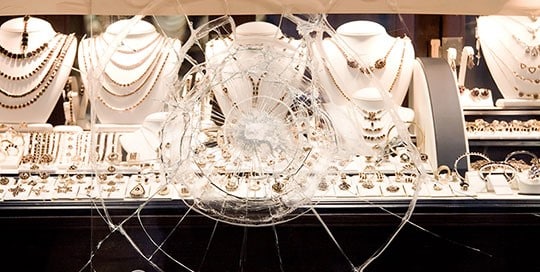By Jewelers Mutual Group
A lot of jewelry crimes that make headlines in the news today revolve around smash-and-grab robberies.
These are often high-profile, brazen attacks that happen quickly and result in high-dollar losses. If you’ve ever seen surveillance footage of one, it almost appears as though nothing could have been done to stop it—but that’s not always the case.
After casing a variety of jewelry businesses, criminals know a soft target when they see one.

Follow these seven tips for preventing smash-and-grab robberies to make your business a hard target, and discouraging criminals from attempting it at your location.
How to Prevent Smash-and-Grab Robberies
1.
Keep your front doors and windows clear of obstructions, so employees can see suspicious persons outside and passersby can see inside.
2.
Use a video surveillance system that has both overt and concealed cameras. Post signs announcing that you have a surveillance system recording images 24 hours a day, with footage monitored and stored off-site. Make sure your security plan is discouraging criminals by ordering free store security signage from Jewelers Mutual Group.
3.
4.
5.
Consider having a mantrap or door buzzer entry system so you’re able to control access to the premises, or at the very least, be aware when someone enters or exits. Keep your employees informed on how to properly admit customers and deal with suspicious incidents.
Here are a few things to consider discussing with your insurance agent:
- Who has the final authority to admit or deny a person at the door?
- What reasons will they give for not granting access to your business?
- Will the police be contacted immediately, or will the incident be reported to a crime network?
- What will your business’s response be in the event of negative publicity?
- Will staff be prepared if a crime still occurs?
6.
Hiring a guard during times of high risk, such as trunk shows, special events, or high-traffic periods can be a major deterrent for criminals. If possible, the guard should be an armed, off-duty, and uniformed police officer.
By selecting a reputable security guard service, you can trust that the guards you work with are certified and licensed by the state and comply with necessary requirements. Below are some specific skills that are also recommended.
Here are a few things to consider discussing with your insurance agent:
- Firearms training
- Evacuation training
- Active shooter training
- Escort training
- Handcuffing techniques
- Certified in CPR
- Taser training
- Pepper spray training
- Baton training
Having an armed guard who possesses additional skills like these may cost extra but, considering the severity of crimes in the jewelry industry, they are well worth the investment. Bold criminals likely may not seem fazed by unarmed guards.
However, the decision to select these services is complex and needs to be addressed under the special circumstances of each jewelry business.
7.
Always have multiple employees on the sales floor. One should always be greeting the customers as they enter, and others should be providing ongoing customer service. An actual customer will enjoy the attention they’ve received, but a criminal might feel uncomfortable and leave.
Here are a few tips on adopting consistent meet-and-greet practices:
- Offer a quick hello and make eye contact.
- Ask questions about the person they are shopping for and if it’s a special occasion.
- Watch for anyone wearing sunglasses, baggy garments or something not appropriate for the season as they may help conceal their identity.
- Pay extra attention to groups of three or more as people don’t typically shop for jewelry in large groups.